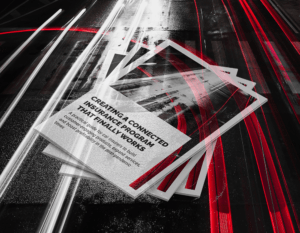
Creating a Connected Insurance Program That Finally Works
A practical guide for car insurers to build customer-engaging products, expand services, and boost profitability in the post-pandemic times.
… Read More
“Any sufficiently advanced technology is indistinguishable from magic.” The best-known technology law formulated by Sir Arthur C. Clark in the ’60s still holds today, when insurance companies can use connected telematics solutions as a competitive lever to improve profitability and expand their customer base. To better understand how that works, we’ll take a step back and examine how telematics has changed over time.
Each of us has experienced technology making great strides in our lifetime. And probably everyone can recall a memorable moment involving technology. For example, was it the first time you typed in a command, and your PC did as told? Or the moment you first entered the VR world? And maybe the minute when you could finally park parallel in the tightest of spots hands-free, thanks to your park assist system?
Every technology has its milestones when advances are made that transform human lives and drive the business forward. So does telematics. It has already become a game-changer for fleet management companies and has gradually become key for forward-thinking insurance companies to evolve their ecosystems and cope with increasing challenges and intensifying competition. But let’s go back to the basics.
According to its dictionary definition, telematics is ‘the area of technology that deals with sending digital information over long distances using wireless forms of communication.’ It allows sending, receiving, and storing of data collected by sensors from remote objects via telecommunication devices.
By fitting it in vehicles (of any kind) or, in the case of mobile app-based alternatives, by porting the GPS tracker in the user’s pocket, telematics devices can collect and read information related to the car’s location, use, servicing, and maintenance requirements, and the driver’s behavior.
In the telematics insurance context, insights about trip data and drivers, such as road conditions, the weather, or driver’s skills, can help improve data-driven decision-making and build new programs and offers for customers. At the same time, by tailoring new, data-based products to particular persons, insurers can deal with specific issues that negatively impact their revenue.
For example, insurance companies can offer more personalized products based on driving behavior, tie premiums to monthly car usage (pay as you drive), or build attractive and unique loyalty programs and discounts that reward drivers for safe and eco-driving. (You can learn more about engaging, converting, and delighting customers with telematics insurance solutions here).
Even though telematics car insurance is a relatively new trend, the telematics technology itself has been around in different levels of progression for the last 60 years. To trace back its beginnings, we need to look at the origins of GPS, Global Positioning System, used by telematics devices to track the coordinates of a vehicle while moving or at rest.
The world’s first global satellite navigation system, called TRANSIT, was created at John Hopkins University APL in 1960. As the Cold War escalated, it primarily served military and intelligence applications. By 1968, it was transitioned to the Navy and expanded to include 36 satellites. However, TRANSIT did not provide enough accuracy of the Earth’s maps despite its constant development.
Other predecessors to modern GPS included, among others, the Timation satellite-based navigation system, developed by the US Navy in the 1960s. Meanwhile, in 1978, Navstar 1 was launched, the first satellite in the GPS. It was developed by the US Air Force and built upon TRANSIT. The same year, the term ‘telematics’ was born, coined by the French in a technology development report. It translates the original word télématique, blending the French words for telecommunications and IT.
Following successful trials of Navstar, the satellite was authorized for civilian commercial airlines by Ronald Reagan in 1983. The first commercially available car navigation system was launched two years earlier by Honda (it was using a helium gas gyroscope to determine the position and distance). In 1990, Mazda introduced the first-ever car navigation based on GPS. As GPS technology continued to improve throughout the next two decades, in 2000, Bill Clinton recognized the importance of GPS access to civilians, and the technology reached the consumer market.
By that time, telematics was already developing. In 1988, Engineering Education and Centers (EEC) launched the first research programs experimenting with vehicle telematics leveraging GPS coordinates. The motivation behind the research was to improve road safety and promote more eco-efficient driving. Notably, the first telematics in insurance was used by Progressive Insurance in the mid-1990s.
Throughout the nineties, GPS technology continued to improve in accuracy and reliability. 1999 marks the first use of GPS in a cellphone, and the next year, performance upgrades were made, improving the signal accuracy for civilians. The proliferation of GPS devices and solutions also dictated a massive decrease in pricing, making the technology available for all.
In parallel to the growing adoption of GPS among consumers, telematics technologies saw their first enterprise uses. Initially, they were embedded mostly in web-based fleet management systems. However, at that time, their performance was still too low for telematics to permeate the mainstream (they could transmit only one to two data instances per hour!)
GPS made telematics possible, while other inventions strongly contributed to its development. One example is the Internet of Things (IoT), a system of interrelated, internet-connected objects that can collect and transfer data over a wireless network without human intervention.
While traditional telematics solutions relied primarily on geographical location and mainly served tracking purposes, IoT made them more sophisticated. By enabling data collection from different devices, IoT sensors have visibility into engine status, fuel usage, car speed, braking, turning, etc.
One more layer of context has been added to telematics solutions by data science and AI. Operating on huge volumes of data, modern telematics-based insurance analytics systems apply contextualization to the collected information, augmenting it with hundreds of elements. Empowered with insights into different mobility-related aspects, insurers can create value from the largest possible amounts of data captured.
For example, using AI-based connected insurance systems, insurers can get detailed trip and drivers profiles that will help them build relevant insurance products tailored to each customer group. Based on these details, they can easily correlate risk insights with loyalty points, rewards programs, or exclusive deals.
Then, 5G comes along. The main advantages of the 5G network are greater speed in the transmissions, lower latency, and therefore greater capacity for remote execution, a larger number of connected devices, and the possibility of implementing virtual networks. These features turn up data transmission speeds to provide near/real-time insights into the car and the driver.
By now, telematics has reached a breaking point. Once the leading insurers go past it, it’s unlikely that customers will accept reverting to traditional insurance offerings leveraging general assessing risks. Instead, the new, tech-savvy consumers expect personalized, expedient, and agile services. Behavioral-based telematics provides the way for insurers to meet these demands immediately. And in this scenario, both sides win.
Customers benefit from insurance telematics through greater price transparency, more affordable premiums aligned with their driving behavior and mobility style, value-added services such as rewards programs and discount packages, and greater overall safety.
On the other hand, insurers get a chance to expand their range of tailored value-added services to net a bigger group of consumers. Using the wider context of analytical insurance solutions, they can offer rewards (and discounts) based on the premise of safe and sustainable driving, improving customer loyalty, retention, and overall satisfaction. Additionally, they can encourage new users to drive before they buy in exchange for a safe-driver discount, or alternatively produce custom pricing based on the driver’s style and mobility needs to make their offers more persuasive (be it in pay-as-you-drive or pay-how-you-drive formats, among others).
When using a customer app to collect trips and interact with the end-user, the options become even broader. By centralizing the insurance customer experience on the mobile device, additional services can be digitalized, like submitting claims, requesting roadside assistance, contacting customer support, renewing or upgrading the policy, and more. All of this is essential to remain competitive, especially considering the decreasing cost and effort it takes customers to switch providers.
Cost-wise, the arguments for integrating telematics into car insurance are also compelling. From lower claim losses (up to 30% reduction), through lower claims handling costs (they can even decrease by half), to improved fraud detection and prevention – all these savings can add up to a hefty sum.
All these benefits and more suggest that the rate of telematics adoption among insurance companies will continue to accelerate within the next few years. Market research back that thesis. In 2020, the usage-based insurance market (UBI) exceeded 30 billion, and it’s expected to grow at over 20% CAGR rate until 2027. While we can expect telematics solutions to evolve during that time (for example, connected vehicle technologies may replace smartphones), the technology is mature enough for insurers to use it to their competitive advantage today.
Key Takeaway: Telematics is not as recent a development as it might seem. The enabling innovations emerged over 60 years ago, and the technology itself is well-established in industries like fleet management and logistics. However, the next chapter for telematics car insurance is opening now. Therefore, insurers should start incorporating it into their ecosystems to offer products that their customers are looking for and willing to purchase.

A practical guide for car insurers to build customer-engaging products, expand services, and boost profitability in the post-pandemic times.
… Read More

Are you ready for a new era of device-free, data-driven Fleet Solutions?
Watch our free webinar to look at the future of #fleetOptimization powered by Connected Car Data. Together with our partner High Mobility, we’ll be looking at the new possibilities that open up thanks to Connected Car Data and how these can empower innovation across the fleet industry. We’ll cover: “What use cases do OEM-connected car data platforms enable?”, “What are its current limitations, and how to tackle them?”, “What to expect of the midterm future?”, and “How connected car data can be leveraged to innovate in the fleet industry?”, among others. Register now and join the discussion.
… Read More

Traditionally, connected insurance uses data from IoT telematics devices to tailor premiums based on driving insights. But today, new ways of building effective connected insurance programs have come into play, like driver safety rewards programs, sustainability and green benefit programs, personalized recommendations, or cross-selling insurance products. To tap into these, insurers must deploy appropriate data collection technology. But what is ‘appropriate’ in this context? … Read More

There are many immediate benefits to launching a connected insurance program—from higher customer engagement and loyalty with rewards, coaching, and reduced claims, to new revenue streams thanks to innovative insurance products. But the jackpot, truly, lies in the long-term vision. To maintain profitability in the long haul, motor insurance companies should already think two steps ahead, reconsidering their data approach today to reap benefits tomorrow. … Read More

The car insurance industry has seen many conversations around the pivotal role of digital technologies, product innovation, and customer-centricity as market differentiators. With these concepts, new terms have emerged to reflect the cutting-edge technologies and the upgraded ways of doing business. Understanding what they mean, how they differ, and what opportunities and constraints they entail, is essential to getting ahead of competitors.
… Read More

“Any sufficiently advanced technology is indistinguishable from magic.” The best-known technology law formulated by Sir Arthur C. Clark in the ’60s still holds today, when insurance companies can use connected telematics solutions as a competitive lever to improve profitability and expand their customer base. To better understand how that works, we’ll take a step back and examine how telematics has changed over time. … Read More
| Cookie | Duration | Description |
|---|---|---|
| cookielawinfo-checkbox-analytics | 11 months | This cookie is set by GDPR Cookie Consent plugin. The cookie is used to store the user consent for the cookies in the category "Analytics". |
| cookielawinfo-checkbox-functional | 11 months | The cookie is set by GDPR cookie consent to record the user consent for the cookies in the category "Functional". |
| cookielawinfo-checkbox-necessary | 11 months | This cookie is set by GDPR Cookie Consent plugin. The cookies is used to store the user consent for the cookies in the category "Necessary". |
| cookielawinfo-checkbox-others | 11 months | This cookie is set by GDPR Cookie Consent plugin. The cookie is used to store the user consent for the cookies in the category "Other. |
| cookielawinfo-checkbox-performance | 11 months | This cookie is set by GDPR Cookie Consent plugin. The cookie is used to store the user consent for the cookies in the category "Performance". |
| viewed_cookie_policy | 11 months | The cookie is set by the GDPR Cookie Consent plugin and is used to store whether or not user has consented to the use of cookies. It does not store any personal data. |
Test drive our API Suite for 30 days!
Tell us a bit about yourself, and we’ll get in touch with you in no time.